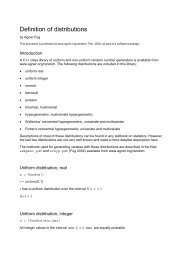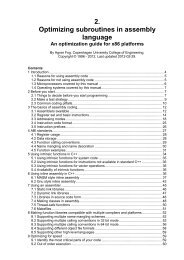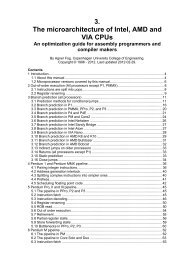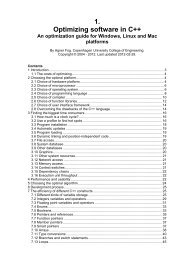4 Instruction tables - Agner Fog
4 Instruction tables - Agner Fog
4 Instruction tables - Agner Fog
You also want an ePaper? Increase the reach of your titles
YUMPU automatically turns print PDFs into web optimized ePapers that Google loves.
Pentium 4<br />
Intel Pentium 4<br />
List of instruction timings and μop breakdown<br />
This list is measured for a Pentium 4, model 2. Timings for model 3 may be more like the values for<br />
P4E, listed on the next sheet<br />
Explanation of column headings:<br />
<strong>Instruction</strong>:<br />
<strong>Instruction</strong> name. cc means any condition code. For example, Jcc can be JB,<br />
JNE, etc.<br />
Operands:<br />
i = immediate constant, r = any register, r32 = 32-bit register, etc., mm = 64 bit<br />
mmx register, xmm = 128 bit xmm register, sr = segment register, m = any<br />
memory operand including indirect operands, m64 means 64-bit memory operand,<br />
etc.<br />
μops: Number of μops issued from instruction decoder and stored in trace cache.<br />
Microcode: Number of additional μops issued from microcode ROM.<br />
Latency:<br />
This is the delay that the instruction generates in a dependency chain if the<br />
next dependent instruction starts in the same execution unit. The numbers are<br />
minimum values. Cache misses, misalignment, and exceptions may increase<br />
the clock counts considerably. Floating point operands are presumed to be<br />
normal numbers. Denormal numbers, NAN's, infinity and exceptions increase<br />
the delays. The latency of moves to and from memory cannot be measured<br />
accurately because of the problem with memory intermediates explained<br />
above under “How the values were measured”.<br />
Additional latency:<br />
Reciprocal<br />
throughput:<br />
Port:<br />
Execution unit:<br />
Execution subunit:<br />
<strong>Instruction</strong> set<br />
Integer instructions<br />
This number is added to the latency if the next dependent instruction is in a<br />
different execution unit. There is no additional latency between ALU0 and<br />
ALU1.<br />
This is also called issue latency. This value indicates the number of clock<br />
cycles from the execution of an instruction begins to a subsequent independent<br />
instruction can begin to execute in the same execution subunit. A value of<br />
0.25 indicates 4 instructions per clock cycle in one thread.<br />
The port through which each μop goes to an execution unit. Two independent<br />
μops can start to execute simultaneously only if they are going through different<br />
ports.<br />
Use this information to determine additional latency. When an instruction with<br />
more than one μop uses more than one execution unit, only the first and the<br />
last execution unit is listed.<br />
Throughput measures apply only to instructions executing in the same subunit.<br />
Indicates the compatibility of an instruction with other 80x86 family microprocessors.<br />
The instruction can execute on microprocessors that support the instruction<br />
set indicated.<br />
Page 133






